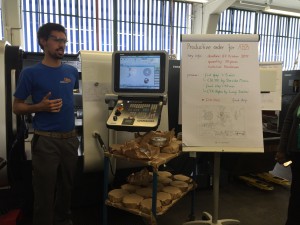This interview with Martin van Os an educational advisor, explores the CTE/VET system in the Netherlands. Van Os began his career as a physics teacher, became a school principal, coordinated the national in-service courses for science and technology, was the senior organizational advisor for the National Center for Urban School Improvement, worked for government on secondary vocational education and was founding director of the Vakcollege support company. This interview was conducted by Katie Fitzgerald of NASDCTEc in part of our ongoing series examining international education systems in partnership with Asia Society’s Global Learning blog on EdWeek.
What are some the steps the Netherlands has or is taking to strengthen CTE?
The urgency of the situation has become clearer and better supported in the last ten years. The economic crisis reminded us that only innovation and creativity would maintain our wealth as a nation, and that we need a high number of excellent, technically educated employers and employees. In response to this sense of urgency, successful Dutch companies and public figures have become involved and are providing inspiration and innovation to the field.
A numbers of actions are being taken to help young people to fulfill their talents with the possibilities the Dutch economy has to offer. Among them are very powerful bottom-up initiatives started by schools and often supported with the help of local companies. Others are powered by government and applied in schools, such as the implementation of career education and guidance and curriculum updates.
Building a chain: Developing career education and guidance
Despite the success with the high quality of individual schools, we are still struggling to provide all students with a successful transition from secondary to tertiary education. About 80 percent of students are successful in their chosen area of study after they finish secondary education. The remaining 20 percent drop out or don’t pursue post-secondary education.
The Dutch government hopes to increase the success of students in their first career choice, both for pedagogical and financial reasons. Currently, secondary schools are monitored and rated based on exams. This reliance on results has led to students taking subjects in which they are comfortable and confident for the test, rather than the subject that will help them in their chosen field of study. Furthermore, exams can easily miss some essential skills, like discipline, motivation and collaboration.
In addition, when students are preparing for post-secondary level of education, there are an abundance of choices without much guidance, so students often turn to their parents for advice – but they are also unclear about CTE fields of study. To address these challenges, the government has made career guidance a requirement of secondary education, and schools are experimenting with how to accomplish this new task. This includes teacher trainings on career guidance to help them understand what skills their students need, and site visits to organizations and colleges.
What are some of the Netherlands’ successful initiatives in Career Technical Education?
A broader curriculum
In 2002, an initiative was launched with schools to develop a broader technical curriculum. In partnership with 10 schools, we developed concepts and practices to make the curriculum attractive to students with various career and educational desires, including students interested in pure technical fields, those who want to apply technical solutions in human services and those who prefer to go into the business sector. Participating schools had to agree to deliver this curriculum successfully with a small number of students to start.
The schools were provided the opportunity to experiment and pilot the curriculum, and after a year of preparation and two years of practice, we followed the first group of students moving into tertiary, or postsecondary, education. We found that these students did as well or better than the traditional groups of students.
With these results, we developed a global curriculum and instruction for student exams. With the support of our stakeholders, the Government accepted the results and put it into legislation. The 10 original schools formed a platform, helping other schools implement this approach and guiding further development.
Currently, over 100 schools have adopted this curriculum and are fully supported by legislation with the support of the platform and stakeholders.
In 2007, a group of entrepreneurs had several observations. First, that a group of students were interested in high-quality and attractive CTE, but the number of schools providing that kind of education were closing or forced to decrease the number of their departments. Second, the perception of CTE was very poor.
After getting support from schools and businesses, I was asked to lead an initiative, Vakcollege, which focused on career knowledge early on for students, and would aim to change the perception surrounding CTE.
We developed three promises for stakeholders. For the students we aimed to develop, “attractive education towards an occupation, diploma and job;†for the companies involved, “a new generation of technicians and craftsmen;†and for the schools our goal is that, “together we make a difference.â€
We started a company, and in 2008 partnered with 13 schools, each with its own assemblage of business partners. We pushed boundaries of what legislation allowed but found out that –to our own surprise- the Dutch system allows schools to change their vision and mission towards more CTE as long as they stay within the boundaries of the various streams.
The initiative has been widely accepted. This summer the company will be replaced by a foundation with 50 schools as members dedicated to furthering the development of Vakcollege.
Technasium
Another successful program we have is Technasium, which began as an elective choice for students offered in the school gymnasium. In this free space, schools offered a new subject they called Research & Development for the more scientific and technical interested students.
This idea was crucial because it offered CTE to students in higher streams, something that these students were not typically exposed to. The most academically gifted pupils were given a chance to explore their talents and interests in CTE fields.
Furthermore, the goal of this initiative was not to develop a standard curriculum, but to work on interesting and innovative questions posed by local companies and businesses in eight-week projects, and present the student solutions to professionals from the companies. Instead of a typical test, student assessment is on their research, solution, creativity, presentation and collaboration.
A foundation has been created that helps schools develop a Technasium program and works closely with the government to set the standards on which schools can join and are allowed to offer exams in Research & Development.
Though these initiatives may have different outcomes, they share the same ambition of developing education, meeting the needs of the students involved, contributing to lasting careers, and helping to provide a pipeline of students with the skills industry needs.
Katie Fitzgerald, Communications AssociateÂ







 In the last post on the Fall Summit I shared that states ended day two by voting on the 24 principles that were crafted during the small group work. I can’t emphasize how grateful I am to all the Summit attendees. Everyone took the charge of defining the Future Directions for CTE very seriously. Attendees brainstormed, crafted, drafted, worked and reworked words until they became statements and statements until they became principles. This is really hard work. And attendees gave it their all!
In the last post on the Fall Summit I shared that states ended day two by voting on the 24 principles that were crafted during the small group work. I can’t emphasize how grateful I am to all the Summit attendees. Everyone took the charge of defining the Future Directions for CTE very seriously. Attendees brainstormed, crafted, drafted, worked and reworked words until they became statements and statements until they became principles. This is really hard work. And attendees gave it their all!
 Choosing Our Words Carefully: With the principles now drafted, we chose to tackle a question that was raised by an attendee on day one – “when we say a term like ‘program of study’ do we all agree on the same definition of what this is and what it looks like to implement this well?†Attendees nodded their heads “yes, but of course we agree and understand these terms. We are all CTE leaders.†However, it became evident during the small group work that even among the selected group at the Summit, terms like programs of study, rigor, seamless and articulation have very different meanings, interpretations and implementation. Attendees spent some time on day three crafting common definitions for 14 terms but this work is far from complete. A charge for us in the future!
Choosing Our Words Carefully: With the principles now drafted, we chose to tackle a question that was raised by an attendee on day one – “when we say a term like ‘program of study’ do we all agree on the same definition of what this is and what it looks like to implement this well?†Attendees nodded their heads “yes, but of course we agree and understand these terms. We are all CTE leaders.†However, it became evident during the small group work that even among the selected group at the Summit, terms like programs of study, rigor, seamless and articulation have very different meanings, interpretations and implementation. Attendees spent some time on day three crafting common definitions for 14 terms but this work is far from complete. A charge for us in the future! So Where Do We Go From Here?: Our Board of Directors met on November 9 to review the Summit work/outcomes and to approve a ‘go forward’ plan that includes a webinar for Summit attendees and a series of regional calls with the state directors in December, as well as a Board of Directors’ retreat in January where the Board will finalize the vision and principles. On February 17, 2010 at 2 pm eastern we will host a webinar to unveil the new vision and corresponding principles. And at the NASDCTEc spring meeting in Washington, D.C. we will once again roll up our sleeves and work together to craft the action steps to achieve our new vision.
So Where Do We Go From Here?: Our Board of Directors met on November 9 to review the Summit work/outcomes and to approve a ‘go forward’ plan that includes a webinar for Summit attendees and a series of regional calls with the state directors in December, as well as a Board of Directors’ retreat in January where the Board will finalize the vision and principles. On February 17, 2010 at 2 pm eastern we will host a webinar to unveil the new vision and corresponding principles. And at the NASDCTEc spring meeting in Washington, D.C. we will once again roll up our sleeves and work together to craft the action steps to achieve our new vision. Looking Ahead: Our organization’s efforts to define a new vision for CTE is not about dismantling what we have in place or discrediting the success we have achieved so far. Instead, it is about looking back on what we have achieved and learning from both our successes and failures. It is about ensuring that the opportunities before CTE are maximized. It is about staying relevant in an ever-changing educational and economic environment. We can’t be what we always have been. In 2009, we don’t look like what we did in 1999; and we shouldn’t look today like we will look like in 2019. We can build on what we have accomplished. With a new vision guiding our work and the right leadership in place, we can get to where we ought to be!
Looking Ahead: Our organization’s efforts to define a new vision for CTE is not about dismantling what we have in place or discrediting the success we have achieved so far. Instead, it is about looking back on what we have achieved and learning from both our successes and failures. It is about ensuring that the opportunities before CTE are maximized. It is about staying relevant in an ever-changing educational and economic environment. We can’t be what we always have been. In 2009, we don’t look like what we did in 1999; and we shouldn’t look today like we will look like in 2019. We can build on what we have accomplished. With a new vision guiding our work and the right leadership in place, we can get to where we ought to be!